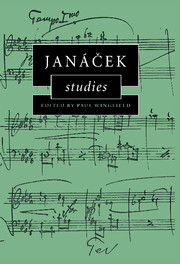Book contents
- Frontmatter
- Contents
- Preface
- 1 Expressive sources and resources in Janáček's musical language
- 2 ‘Nothing but pranks and puns’: Janáček's solo piano music
- 3 Narrative in Janáček's symphonic poems
- 4 Evasive realism: narrative construction in Dostoyevsky's and Janáček's From the House of the Dead
- 5 Direct discourse and speech melody in Janáček's operas
- 6 Kundera's eternal present and Janáček's ancient Gypsy
- 7 Janáček's folk settings and the Vixen
- 8 Janáček's operas in Australia and New Zealand: a performance history
- 9 Janáček's Moravian publishers
- 10 Janáček, musical analysis, and Debussy's ‘Jeux de vagues’
- Index
5 - Direct discourse and speech melody in Janáček's operas
Published online by Cambridge University Press: 22 September 2009
- Frontmatter
- Contents
- Preface
- 1 Expressive sources and resources in Janáček's musical language
- 2 ‘Nothing but pranks and puns’: Janáček's solo piano music
- 3 Narrative in Janáček's symphonic poems
- 4 Evasive realism: narrative construction in Dostoyevsky's and Janáček's From the House of the Dead
- 5 Direct discourse and speech melody in Janáček's operas
- 6 Kundera's eternal present and Janáček's ancient Gypsy
- 7 Janáček's folk settings and the Vixen
- 8 Janáček's operas in Australia and New Zealand: a performance history
- 9 Janáček's Moravian publishers
- 10 Janáček, musical analysis, and Debussy's ‘Jeux de vagues’
- Index
Summary
Introduction
One important aspect of Janáček's original approach to musical narratology has not hitherto been examined in detail. This concerns what modern narrative theory terms ‘direct discourse’: i.e. ‘a “quotation” of a monologue or a dialogue’ (whether actual or conjectured), which ‘creates the illusion of “pure” mimesis’. Direct discourse occurs in Janáček's opera librettos from the very start. Moreover, this mode of speech presentation is one of the most important narrative principles in the libretto of his last opera, Z mrtvého domu (From the House of the Dead; 1927–8). The aim of my essay is to examine chronologically key moments containing direct discourse in Janáček's eight operas leading up to From the House of the Dead, and to demonstrate that the composer displays a progressive awareness of the considerable dramatic potential of this conventional narrative resource.
There is an obvious initial question: is there any relationship between direct discourse and Janáček's almost lifelong preoccupation with ‘speech melodies’ (nápěvky mluvy)? Speech melodies are essentially stylised snippets of everyday speech written in conventional musical notation. Janáček apparently began to collect them, from a wide variety of real-life situations, in around 1897, by which time he had already completed two operas: the mythological Šárka (1887; rev. 1888, 1918–19 and 1925), after an almost decadent libretto by Julius Zeyer; and Počátek románu (The Beginning of a Romance; 1891; rev. 1892), a comic opera in the Singspiel tradition.
- Type
- Chapter
- Information
- Janácek Studies , pp. 79 - 108Publisher: Cambridge University PressPrint publication year: 1999
- 3
- Cited by

